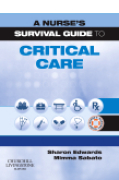
This small, pocket-size book provides a solid introduction to aspects of careand management in critical care. The book contains not only information on patient assessment, ventilation, haemodynamic monitoring, emergencies, critical care interventions, common conditions and pharmacology, all clearly relating to critical care, but also psychological, professional practice issues, palliative care and caring for relatives. The aim is to provide, in an accessible format, the factual information needed to assist nurses in providing holistic care in the critical care environment. INDICE: Introduction Focus of the book HDU/CCU/ITU/post anaesthetic care; 1 General introduction to critical care - What to expect, The MDultidisciplinary Team, Communication, Care planning, Critical thinking, Nursing knowledge, Infection control issues, Outreach programmes/ALERT,Government directive in critical care; 2 Patient assessment - Nutritional assessment, Pressure sore risk assessment, Neurological assessment, Pain assessment, Wound assessment, Sedation assessment scoring, APACHE scoring/other types of scoring available in critical care e.g. SAPS; 3 Intubation and ventilation - Types and modes of ventilation, CPAP, PEEP, BiPAP, NIPPY, Non-invasive ventilation, Administration of oxygen, Arterial blood gases, End tidal carbon dioxide monitoring, Oxygen saturation monitoring, Tracheostomy; 4 Haemodynamic monitoring - Non-invasive haemodynamic monitoring, Temperature, Heart rate/pulse rate, BP, Urine output, External Doppler monitoring,Invasive haemodynamic monitoring, Arterial blood pressure monitoring, CVP, PAP, CO, PAWP, SVR, PICCO, Phi measurement, Oesphageal Doppler monitoring; 5 Diagnostic procedures -Pleural effusion, Lumber puncture, CT scan, MRI scan,Bronchoscopy, Ultrasound, X-Ray, Blood results; 6 Emergencies- Principles of cellular death, injury and repair,IIR, Hypoxic cellular damage, Shock (anaphylaxis, septic, cardiogenic, neurogenic, hypovolaemic), Insertion of a chest drain, Cardiac arrest, DC shock, CPR, BLS, ALSSIRS, DIC, MSOF; 7Critical care interventions -Blood transfusions, EF/PN, Fluid replacement therapy, colloids, crystalloids, Re-warming procedures - hypothermia, ICP monitoring, Synchronised cardioversion, Helium oxygen mix during ventilation, Intra aortic balloon pump (IABP), Nitric Oxide, Extra corporeal membrane oxygenation (ECMO), Mouth care of an intubated patient, Passive movements, Skin integrity,Prone nursing, Transplantation, Haemofiltration/Renal Replacement Therapy; 8 Common conditions/reasons for admission to critical care - Pancreatitis,Post operative Liver failure, Trauma, Burns,Myocardial infarction, Invasive haemodynamic monitoring, Ventilation, Shock; 9 Pharmacology -Pharmacokinetics and pharmacodynamics, Drug calculations, Nurse prescribing, Drug administration and equipment, AnalgesiaSedation, muscle relaxants, Nebulisers, Antiobiotics, Inotropes; 10 Psychological care -Sleep, sleep deprivation, Sensory overload and deprivation, Communicating with the patientICU syndrome; 11 Professional practiceissues - Ethical and legal issues, Principles/processes, Philosophy, Confidentiality, Decision-making, Health promotion/education issues; 12 Palliative care - Caring for the dying patient, Brain stem death tests, Organ donation, Cultural/religious beliefs; 12 Caring for relatives - Supporting relatives, Communication, Information giving, Visiting times, Follow up clinics; 13 Conclusion.
- ISBN: 978-0-443-10417-6
- Editorial: Churchill Livingstone
- Encuadernacion: Rústica
- Páginas: 476
- Fecha Publicación: 24/07/2009
- Nº Volúmenes: 1
- Idioma: Inglés
